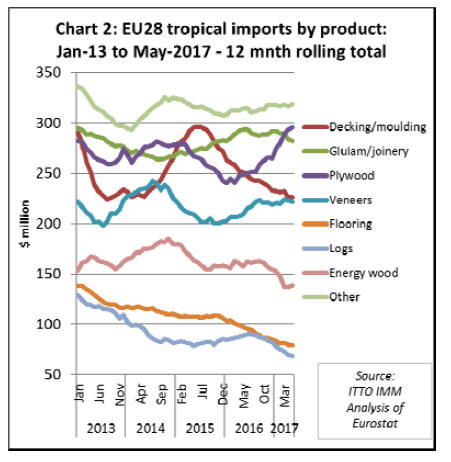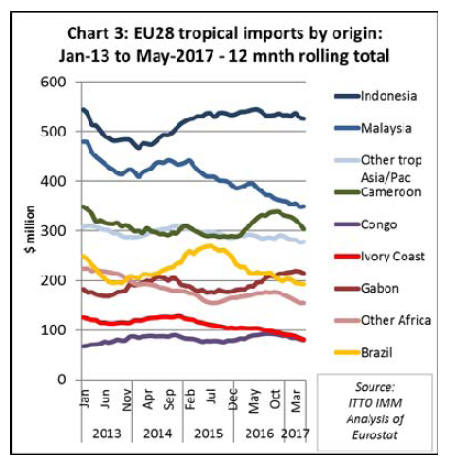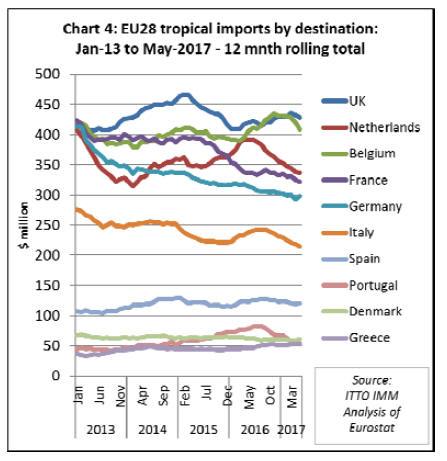|
Report from
Europe
European market for tropical wood slows again
Although overall economic conditions are improving in
Europe, growth in key countries and sectors for the
tropical hardwood sector is subdued and weakening in
some cases.
The European Commission currently forecasts GDP
growth in the EU to remain level at 1.9% in both 2017 and
2018. However, private consumption, the main growth
driver in recent years which expanded at its fastest pace in
10 years in 2016, is set to moderate this year as inflation
partly erodes gains in the purchasing power of households.
Investment is expected to expand fairly steadily in the EU
but remains hampered by the modest growth outlook.
Unemployment continues its downward trend, but it
remains high in many European countries. In the euro
area, it is expected to fall to 9.4% in 2017 and 8.9% in
2018.
Meanwhile the European market for tropical wood which,
after a long period of decline, stabilised at a low level
between 2014 and 2016, has generally slowed again this
year.
Charts 1 to 4 show the monthly trend in imports of tropical
wood products into the EU to May 2017 using 12 month
rolling totals. This is calculated for each month as the total
import of the previous 12 months. The data removes shortterm
fluctuations due to seasonal changes in supply and
shipping schedules and provides a clear indication of the
underlying trade trend.
Trade value is reported in US dollars, rather than in Euro,
to provide a clearer indication of demand from the
perspective of exporters into Europe. Because the Euro
and other European currencies depreciated sharply against
the US dollar between June 2014 and June 2016, the
switch to reporting in US dollars has a significant impact
on the trade trend.
40-month stasis in dollar value of EU tropical wood
imports
While the euro value of tropical wood product imports into
the EU increased 20% between mid-2014 and mid-2016,
the value reported in US dollars remained almost static.
Chart 1 shows the US dollar value of EU imports value of
all wood products listed in Chapter 44 of the HS codes
sourced from tropical countries. It highlights that the 12-
month rolling total remained consistent at around US$2.5
billion for a 40-month period between the middle of 2013
and end of 2016.

Chart 1 also highlights that the US dollar value of EU
tropical wood products imports was declining in the first
five months of 2017. Much of this decline is attributable to
sawn wood, for which the 12-month rolling total fell from
US$865 million in December 2016 to US$795 million in
May 2017.
This year has seen a significant slowdown in the volume
of sawnwood trade between Cameroon and Belgium,
which in 2016 overshadowed all other tropical sawnwood
trade flows into the EU. In the first five months of 2017,
Belgium¡¯s imports of tropical sawnwood were US$88
million, down 22% compared to the same period in 2016.
The tropical sawnwood trade in the Netherlands also
declined in the first five months of 2017, by 18% to
US$57 million. However, after a very slow start to the
year, trade was beginning to pick up in the second quarter.
Imports from Malaysia were strengthening during this
period, responding to the Dutch government¡¯s decision in
January to recognise MTCS certified wood as conformant
to national procurement criteria for ¡°sustainable¡± timber.
Elsewhere in Europe, the US dollar value of direct imports
of tropical sawnwood in the first five months of 2017
declined in the UK (-8% to US$32 million), France (-21%
to US$31 million), Italy (-33% to US$29 million),
Germany (-2% to US$22 million), and Spain (-17% to
US$19 million).
Changing product mix in EU tropical wood trade
Chart 2 shows the US dollar value trend in EU imports of
tropical wood products other than sawnwood. It highlights
that, while there has been relative stability in the total
value of imports, there is considerable flux in the product
mix.

EU imports of tropical decking have been particularly
volatile in the last three years, rising sharply in 2015 and
declining in 2016 and the first half of 2017. The recent
decline is mainly due to intensifying competition from
alternatives, notably wood plastic composites and
modified temperate wood species.
In contrast, imports of tropical hardwood plywood have
been rising rapidly and continuously since the start of
2016. All the gains have been in imports of tropical
hardwood plywood from Indonesia and China, with a
rising proportion destined for the UK and Belgium.
The EU plywood market has been an early target for
EUTR regulatory checks. As a result, Indonesian product
is now receiving a boost from the ¡°green lane¡± through
EUTR provided by FLEGT licenses. There is also greater
focus on ensuring that plywood imported from China
contains only wood material of known species and origin,
so that more is now positively identified as faced with
tropical hardwood.
EU imports of tropical veneers were rising in 2016, but the
pace of increase has slowed in 2017. Roughly half the
tropical veneer imported into the EU is rotary okoume
veneer from Gabon to supply plywood manufacturers,
mainly in France, and the remainder is decorative veneer,
mainly from Ivory Coast and Cameroon and mostly
destined for Italy. Meanwhile EU imports of other tropical
wood products, including energy wood, flooring and logs
have been sliding in 2017.
Indonesia increases share in declining EU market
Chart 3 shows how the fortunes of the various tropical
supply countries are changing in the EU market. Indonesia
has become more firmly established as the leading tropical
supply country into the EU this year. While the dollar
value of EU imports from Indonesia has remained static
since the start of 2016, import value from most other
leading supply countries has been declining.

This provides context for those concerned about the
apparent lack of market growth for Indonesian wood
products in the EU since issue of the first FLEGT licenses
in November 2016. While total imports from Indonesia are
not rising, they are stable in a market which is generally
declining and Indonesia is increasing share compared to
other tropical supply countries.
The dollar value of EU imports of tropical wood products
from Malaysia fell almost continuously in the two years up
to March 2017, with a notable decline in Dutch and
German imports of sawnwood and UK imports of
Malaysian plywood. However, there were some early
signs of EU imports of Malaysian products picking up
again in April and May this year.
EU imports from Cameroon, mainly sawnwood and
mostly imported into Belgium, spiked in the second half of
2016 and subsided rapidly in the first five months of 2017.
EU imports from Congo and Gabon have also slowed in
2017 after a strong performance in the second half of
2016. Meanwhile the long-term decline in EU imports
from Ivory Coast has continued in 2017. Imports from
Brazil have also declined consistently in the last two years.
Rising uncertainty in the UK market
Chart 4 shows that over the last 4 years, the UK has been
the largest single destination for tropical wood imports
into the EU. The focus on direct imports also
underestimates the influence of the UK since a proportion
of sawnwood imported by Belgium and the Netherlands
from Africa is also sold into the UK after kiln drying on
the continent.

The UK market for tropical hardwood remained more
resilient than many expected in the second half of 2016,
despite the uncertainty caused by the Brexit vote in June
2016 which led a 15% fall in the value of the British
pound against the dollar in the third quarter of the year.
However, concerns are now mounting about economic
conditions in the UK. The UK economy was the worst
performer in the EU in the opening months of 2017 as the
Brexit vote at last began to take its toll. With economic
growth of just 0.2% in the first three months of this year,
the UK was well behind its European neighbours (growth
for the whole of the EU was 0.6% in the first quarter).
The latest British Woodworking Federation survey of
joinery activity in the U.K. reinforces this picture of
subdued demand. The survey shows slowing growth and
tightening margins in this sector during the first quarter of
2017. The weakness of the British pound and associated
rising inflation are identified as dampening factors. While
stair manufacturers had a good quarter, manufacturers of
internal and external doors had more mixed results.
Recent business surveys suggest the UK economy picked
up some momentum in the second quarter after its slow
start to 2017. But with higher inflation weighing on
consumer spending, most forecasters expect growth to be
lackluster during the rest of 2017. The snap election called
for June 2017, which led unexpectedly to a hung
parliament and undermined the authority of the current
Conservative government, has only served to increase the
uncertainty.
Positive indications in Benelux
Imports of tropical wood products into Belgium and the
Netherlands were mirror images of each other in the
second half of 2016, rising very rapidly into the former
while declining in the latter.
Given that both countries are important centres for
distribution of tropical wood to other parts of Europe,
these trends are more likely associated with short-term
logistical factors favouring transit via ports in Belgium
over those in the Netherlands, than with changes in
internal demand in the two countries.
In fact, underlying market conditions in each country
appear to be reasonably good. There was robust growth in
construction output in both the Netherlands and Belgium
in 2016, and this trend continued into the first quarter of
2017.
The Belgian economy expanded 0.64% in the first quarter
of 2017 compared to the quarter, the highest quarterly
growth rate since 2011, driven by an uptick in private
consumption. In the Netherlands, a buoyant labour market
together with rising wages and house prices and upbeat
consumer sentiment are fuelling household spending.
There is also optimism that the Dutch government¡¯s
decision to recognise MTCS as ¡°sustainable¡± will boost
prospects for Malaysian timber in the Netherlands in the
next few years, particularly as both the government and
the Netherlands Timber Trade Association share a
commitment to ensure that at least 90% of tropical timber
imports derive from sustainable sources by 2020.
French economy boosted by election results
France has been a weakening market for tropical wood in
recent times, both due to sluggish economic growth and to
substitution by alternative materials, including European
timbers and non-wood products.
However, there is now better news on the economic side.
France¡¯s economy grew by 0.4% in the first three months
of the year, stronger than the 0.3% initially estimated by
statisticians. That suggests the economy is moving in the
direction indicated by surveys which show business
activity growing at the fastest pace for seven years.
French consumer confidence has climbed this year to its
highest level for a decade, according to the national
statistics agency INSEE. The EC¡¯s sentiment data for
France is also at a six-year high and shows improvements
across all the sectors it monitors - industry, services, retail,
consumer and construction.
Economic sentiment was given another boost by the
outcome of the French elections in June, which delivered a
new centrist President at the head of a party with an
absolute Parliamentary majority. The new government¡¯s
election manifesto emphasised the need to reduce the
budget deficit and increase confidence in the business
environment. The new government now forecasts GDP
growth of 1.6% this year and 1.7% in 2018.
However, the new government will have to walk a fine
line to deliver on its promises. It is committed both to
reducing the budget deficit to below 3% in line with eurozone
rules, and to a big cut in taxes on individuals and
businesses of around 11 billion euros next year.
To achieve this, it intends to reign in public spending and
to liberate France¡¯s rigid labour market laws, measures
that will likely meet ferocious opposition from unions and
labour groups.
Economic growth in Germany not benefitting tropical
suppliers
The German economy got off to a strong start this year,
according to official GDP figures released by the German
Statistics Institute in May. GDP growth accelerated and
was well balanced, with all main categories accelerating.
The positive momentum seems to have carried over to the
second quarter, with confidence indicators reaching alltime
highs and signs of particularly strong growth in the
German construction sector.
Some hardwood product sectors are benefitting from this
growth. For example, the European wood flooring
association FEP reports that parquet sales in the first
quarter of the current year remained stable building good
performance recorded in 2017.
Despite the underlying strength of the economy, Chart 4
highlights that German imports of tropical wood have
been in continuous decline in the last five years. This is a
clear indication of the mounting pressure on tropical wood
from substitute products in Germany. EUTR regulatory
concerns have also deterred German importers concerned
about the legality risks associated with buying tropical
timbers
Italy lags further behind
Italy is another market where tropical wood imports have
been in almost continuous decline in recent times. In this
instance, the trend is more readily explained by poor
underlying economic conditions.
Italy¡¯s economy is lagging further behind its European
peers. Recently released data shows that GDP expanded
just 0.2% from the previous quarter in the first quarter of
2017, less than half the 0.5% growth recorded in the Euro
area. Private consumption, which was the main driver of
growth last year, is gradually weakening, restrained by
rising inflation, a stubbornly high unemployment rate and
feeble wage increases - a consequence of stagnant
productivity.
However there are some more positive signs emerging.
According to Euroconstruct, residential renovation and
new non-residential buildings are increasing in Italy and
only new residential construction is still declining.
Spanish economy improves but tropical wood demand
still flat
Imports of tropical wood into Spain have been static
overall at a low level in recent years. However, market
prospects are beginning to improve. The Spanish economy
continues to build momentum as stronger-than-expected
dynamics in the first quarter of 2017 have carried over into
second.
Households are now benefitting from higher real estate
prices and robust job creation. The residential housing
sector is improving. For the first time since the crisis, there
were more housing starts than completions in 2016.
Other leading data points to a better-performing economy
in Spain this year, with both the services and
manufacturing purchasing managers indices accelerating
markedly in April and exports expanding at the fastest
pace on record in the first quarter. Spain¡¯s economy is
expected to grow 2.7% in 2017.
|